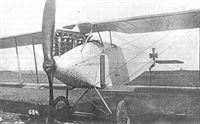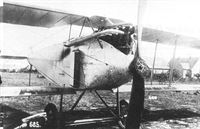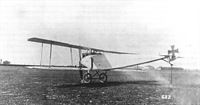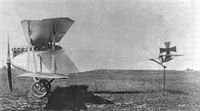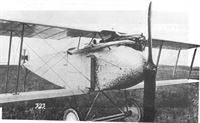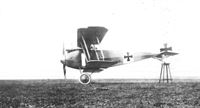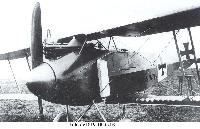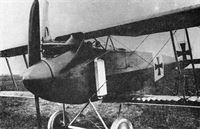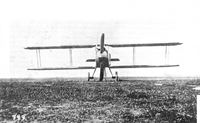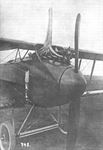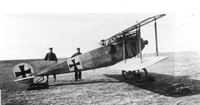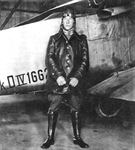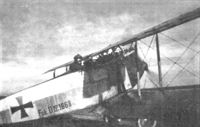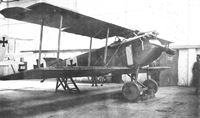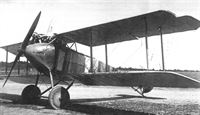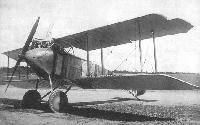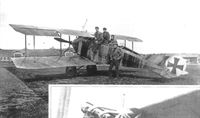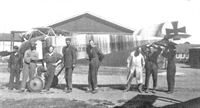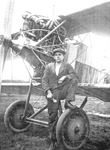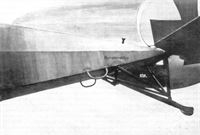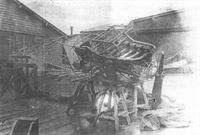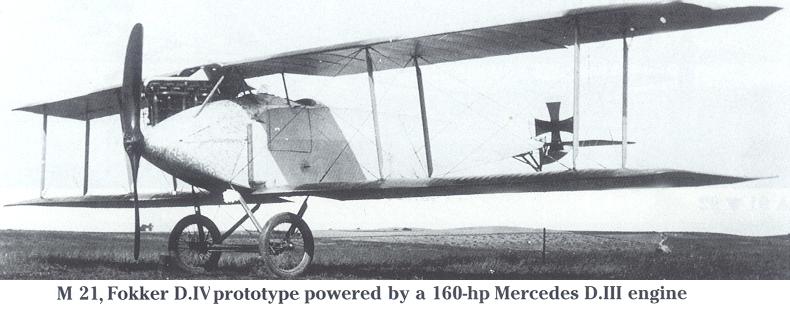
Описание
Страна: Германия
Год: 1916
Варианты
- Fokker - D.I / M.16 / M.18 - 1916 - Германия
- Fokker - D.IV / M.20 / M.21 - 1916 - Германия
- В.Кондратьев Самолеты первой мировой войны
- A.Weyl Fokker: The Creative Years (Putnam)
- J.Herris, J.Leckscheid Fokker Aircraft of WWI. Vol.3: Early Biplane Fighters (A Centennial Perspective on Great War Airplanes 53)
- J.Herris Fokker Aircraft of WWI. Vol.6: Foreign Service (A Centennial Perspective on Great War Airplanes 56)
- J.Forsgren Swedish Military Aircraft 1911-1926 (A Centennial Perspective on Great War Airplanes 68)
- O.Thetford, P.Gray German Aircraft of the First World War (Putnam)
- W.Green, G.Swanborough The Complete Book of Fighters
- P.Grosz, G.Haddow, P.Shiemer Austro-Hungarian Army Aircraft of World War One (Flying Machines)
- E.Hauke, W.Schroeder, B.Totschinger Die Flugzeuge der k.u.k. Luftfahrtruppe und Seeflieger 1914-1918
-
J.Herris, J.Leckscheid - Fokker Aircraft of WWI. Vol.3: Early Biplane Fighters /Centennial Perspective/ (53)
Fokker D.IV, Hans von Keudell, Jasta 1, 1916
-
J.Forsgren - Swedish Military Aircraft 1911-1926 /Centennial Perspective/ (68)
Fokker D.IV in Swedish service, 1917
-
J.Herris - Fokker Aircraft of WWI. Vol.6: Foreign Service /Centennial Perspective/ (56)
Fokker D.II(MAG) 04.55
-
Сайт - Pilots-and-planes /WWW/
M 21, Fokker D.IV prototype powered by a 160-hp Mercedes D.III engine
-
J.Herris, J.Leckscheid - Fokker Aircraft of WWI. Vol.3: Early Biplane Fighters /Centennial Perspective/ (53)
Compared to the previous photo, the stagger of the inner struts is easier to note here. The long fuselage was probably intended to improve directional stability, and in combination with the large wingspan the proportions of the aircraft leave an impression that it was somewhat oversized. (Peter M. Grosz collection/STDB)
-
J.Herris, J.Leckscheid - Fokker Aircraft of WWI. Vol.3: Early Biplane Fighters /Centennial Perspective/ (53)
Frontal view of the first M.21 vividly illustrates the huge wingspan of this experimental aircraft. The stagger of the inner struts appears more subtle from this angle. No tailfin was fitted to this aircraft. The horn balanced ailerons were finally developed to a point that they became a standard design feature.
-
J.Herris, J.Leckscheid - Fokker Aircraft of WWI. Vol.3: Early Biplane Fighters /Centennial Perspective/ (53)
The downward-facing exhaust has already left a dark stain on the side of the fuselage at the time the photo was taken. The bright summer sunshine highlights the translucency of the fabric which shows nicely just behind the stain. No drag wire going from the nose to the bottom of the forward inner strut was fitted on this plane.
-
J.Herris, J.Leckscheid - Fokker Aircraft of WWI. Vol.3: Early Biplane Fighters /Centennial Perspective/ (53)
A better look at the upper wing and horizontal tailplane camouflage applied to wn 782 is offered by this three-quarter rearview, in which the tail rests on the ground for once. The lack of a tail fin makes the fuselage design ancestry going way back to the E.I plainly obvious. From this perspective, the straight outer struts almost seem angled backwards!
-
J.Herris, J.Leckscheid - Fokker Aircraft of WWI. Vol.3: Early Biplane Fighters /Centennial Perspective/ (53)
One of the three special Fok. D.IVs with long-span wings.
-
J.Herris, J.Leckscheid - Fokker Aircraft of WWI. Vol.3: Early Biplane Fighters /Centennial Perspective/ (53)
The first M.21 to be built carried the Werknummer 782. In the original photograph, this can barely be made out above the bottom fuselage longeron, above the centre of the lower wing root just behind the radiator. It was also applied to the bottom of the rudder. The pointed nose exposed most of the forward engine cylinders, this detail as well as the staggered inner struts and straight outer struts were identifying features of this machine. Note washout on the lower wingtip.
-
J.Herris, J.Leckscheid - Fokker Aircraft of WWI. Vol.3: Early Biplane Fighters /Centennial Perspective/ (53)
The next M.21 with the Werknummer 927 followed soon, and it exhibited several differences. Both wings were straight-edged and swept slightly forward to maintain its center of lift behind its center of gravity. The wingspan was shortened by reducing the number of wing ribs by three on each side. The horn-balanced ailerons show well from this perspective.
The M 21 prototype was the last Fokker fighter design ascribed solely to Martin Kreutzer. -
J.Herris, J.Leckscheid - Fokker Aircraft of WWI. Vol.3: Early Biplane Fighters /Centennial Perspective/ (53)
The reduced wingspan and shorter fuselage gave wn 927 a more purposeful, compact appearance. Wheel covers are now in place, but no armament is installed. (Peter M. Grosz collection/STDB)
-
J.Herris, J.Leckscheid - Fokker Aircraft of WWI. Vol.3: Early Biplane Fighters /Centennial Perspective/ (53)
The more bulbous nose of the second M.21 shows well in this view. In a very sensible manner, the modified exhaust now directs the fumes away from the airframe. The drag wire connecting the bottom of the forward inner wing strut to the nose section is missing, although production D.Is already had them at this point.
-
J.Herris, J.Leckscheid - Fokker Aircraft of WWI. Vol.3: Early Biplane Fighters /Centennial Perspective/ (53)
A low side view illustrates the forward stagger of the wings perfectly. Note the glossy appearance of the bottom fabric applied to the upper wing. No tail fin is fitted, and the Werknummer 927 can barely be seen on the bottom of the rudder.
-
J.Herris, J.Leckscheid - Fokker Aircraft of WWI. Vol.3: Early Biplane Fighters /Centennial Perspective/ (53)
Fokker D.IV 1640/16 was the first aircraft of the only production batch of 40. It was not a standard production D.IV; instead it featured a redesigned nose with large spinner and more streamlined contours. This modification was probably Fokker's attempt to emulate the streamlined Albatros fighters which also had large spinners. However, it was the only Fokker D.IV so modified. (Peter M. Grosz collection/STDB)
-
Сайт - Pilots-and-planes /WWW/
Fokker D.IV, 1640/16
-
A.Weyl - Fokker: The Creative Years /Putnam/
This Fok. D.IV, No. 1640/16, had an improved engine installation with a large spinner.
-
J.Herris, J.Leckscheid - Fokker Aircraft of WWI. Vol.3: Early Biplane Fighters /Centennial Perspective/ (53)
Fokker D.IV 1640/16 was the first aircraft of the only production batch of 40. It was not a standard production D.IV; instead it featured a redesigned nose with large spinner and more streamlined contours. This modification was probably Fokker's attempt to emulate the streamlined Albatros fighters which also had large spinners. However, it was the only Fokker D.IV so modified. (Peter M. Grosz collection/STDB)
-
J.Herris, J.Leckscheid - Fokker Aircraft of WWI. Vol.3: Early Biplane Fighters /Centennial Perspective/ (53)
Fokker D.IV 1640/16 was the first aircraft of the only production batch of 40. It was not a standard production D.IV; instead it featured a redesigned nose with large spinner and more streamlined contours. This modification was probably Fokker's attempt to emulate the streamlined Albatros fighters which also had large spinners. However, it was the only Fokker D.IV so modified. The photo reveals that it s upper wing still had the upturned leading in the center section to improve the pilots' field of view. (Peter M. Grosz collection/STDB)
-
M.Dusing - German Aviation Industry in WWI. Volume 1 /Centennial Perspective/ (84)
Fok D.IV with experimental nose (M21). (1916)
-
J.Herris, J.Leckscheid - Fokker Aircraft of WWI. Vol.3: Early Biplane Fighters /Centennial Perspective/ (53)
Additional views of Fokker D.IV 1640/16, the first aircraft of the only D.IV production batch of 40. It featured a redesigned nose with large spinner and more streamlined contours. However, it was the only Fokker D.IV so modified.
-
Сайт - Pilots-and-planes /WWW/
Fokker D.IV, 1651/16 flown by a training unit.
-
J.Herris, J.Leckscheid - Fokker Aircraft of WWI. Vol.3: Early Biplane Fighters /Centennial Perspective/ (53)
Lacking armament but with the engine running, Fokker D.IV 1653/16 also lacks its wheel covers, exposing the spokes. The barely legible inscription on the tail identifies this aircraft as being the aircraft of the "Kommandeur der Fliegerschule LVG Koslin". At Koslin (now Koszalin) FEA 2 was located, and besides manufacturing aeroplanes, the L.V.G. aircraft company also operated a military flying school there.
-
J.Herris, J.Leckscheid - Fokker Aircraft of WWI. Vol.3: Early Biplane Fighters /Centennial Perspective/ (53)
Unknown student pilot with Fokker D.IV 1662/16 at a training unit.
-
J.Herris, J.Leckscheid - Fokker Aircraft of WWI. Vol.3: Early Biplane Fighters /Centennial Perspective/ (53)
Fokker D.IV 1668/16 with pilot and running engine.
-
J.Herris, J.Leckscheid - Fokker Aircraft of WWI. Vol.3: Early Biplane Fighters /Centennial Perspective/ (53)
"Фоккер" D.IV с двигателем "Мерседес" на фронтовом аэродроме, 1917 г.
Like the Albatros fighters, the Fokker D.IV was powered by the 160 hp Mercedes D.III, which Fokker claimed he could not get for his designs. The Fokker D.IV carried two machine guns but could not compete with the performance, maneuverability, or structural strength of the Albatros fighters.
Ltn. Hans von Keudell of Jasta 1 received one of the first (if not the first) Fokker D.IV to reach the front; the 'K' on the fuselage was his personal insignia. This particular aircraft features several features not seen on the later production D.IV: the fuselage and wings were painted in the two-color segmented camouflage scheme seen on many D.I - D.III aircraft. An additional drift wire, extending from the nose to the bottom of the forward inner strut, has been fitted. Radiators with a flat top and bottom are mounted to the fuselage sides, and larger wheels have been fitted. The cabane strut arrangement differs from the usual D.IV design, too, featuring a single vertical rear strut rather than the usual "inverted V" arrangement. The laced section below the cockpit also extends further down than on production aircraft, extending below the horizontal fuselage stringer. The struts of this aircraft may have been painted green, but the photo does not show this detail clearly. No other D.IV featuring all these details has been documented in photographs, and this may have been an experimental machine shipped to the front for evaluation purposes. -
J.Herris, J.Leckscheid - Fokker Aircraft of WWI. Vol.3: Early Biplane Fighters /Centennial Perspective/ (53)
Another unidentified and unarmed Fokker D.IV seen in the hangar of a flying school or FEA. The landing gear has been placed on a trestle in order to relieve pressure from the tires. The dense application of the camouflage streaks compared to 1662/16 above is noteworthy.
-
J.Herris, J.Leckscheid - Fokker Aircraft of WWI. Vol.3: Early Biplane Fighters /Centennial Perspective/ (53)
In 1917 Sweden bought a small batch of 4 Fokker D.IV fighters; these were powered by the 150 hp Benz Bz.III engine. That accounts for the different exhaust on the left side of the engine and the shorter nose contours. (Peter M. Grosz/STDB)
-
В.Кондратьев - Самолеты первой мировой войны
"Фоккер" D.IV c мотором "Бенц".
The picture shows one of the four Fokker D.IV machines acquired by Sweden in 1917 (less engines and armament). When they were delivered the machines were hidden in a hangar at Stockholm aerodrome and were never flown. The precious engines were never installed, but used for other purposes. Even the national colours of Sweden were not painted on. These aircraft were payed for by public subscription, and were intended for the air-defence of the Swedish capital. A contract was signed with Fokker on 24 January 1917, for the delivery of 4 DIV Doppeldecker neuesten Typs. The aircraft were not delivered until March 1918, and were then placed in a hangar and never flown. The aircraft were not assigned to the Swedish Flying Corps, due to unknown bureaucratic reasons. Permission to fly the aircraft were not given until 1920, but by then, more modern aircraft were available in abundance. -
J.Herris - Fokker Aircraft of WWI. Vol.6: Foreign Service /Centennial Perspective/ (56)
Four Fokker D.IV's were acquired in 1918, but were never flown by the AFK. This picture was taken at Malmen in the early 1920's. Via Swedish Aviation Historical Society
-
J.Herris, J.Leckscheid - Fokker Aircraft of WWI. Vol.3: Early Biplane Fighters /Centennial Perspective/ (53)
Fuselage of the same Fokker D.IV aircraft bought by Sweden.
-
J.Herris, J.Leckscheid - Fokker Aircraft of WWI. Vol.3: Early Biplane Fighters /Centennial Perspective/ (53)
A mechanic with one of the D.IVs that were sold to Sweden that were fitted with the Benz Bz.III. Even though the Bz.III was earmarked for Naval Service at this time, either the Swedish military officials specified this engine, or, more likely, were denied access to the Mercedes D.III since it was in high demand for German fighters. (Jorn Leckscheid)
-
J.Herris, J.Leckscheid - Fokker Aircraft of WWI. Vol.3: Early Biplane Fighters /Centennial Perspective/ (53)
Detail view of a production D.IV with the Werknummer 1096, which may equate to D.IV 1647/16. The production-aircraft tail fin is now in place, and the streaked camouflage finish highlights the fuselage central stringer which does not show very well on the doped fabric of the first two M.21 experimental machines.
-
J.Herris, J.Leckscheid - Fokker Aircraft of WWI. Vol.3: Early Biplane Fighters /Centennial Perspective/ (53)
Fokker D.IV fuselage structure shows the engine was buried in the welded steel tubing. This was a major problem for engine repairs or replacement in the field and was also a production problem; the engine had to be installed before the steel tubing structure was completed. (Peter M. Grosz collection/STDB)
-
J.Herris, J.Leckscheid - Fokker Aircraft of WWI. Vol.3: Early Biplane Fighters /Centennial Perspective/ (53)
Fokker D.IV production fuselages with fuel tanks installed stored at the Fokker factory. (Peter M. Grosz collection/STDB)
-
J.Herris - Fokker Aircraft of WWI. Vol.6: Foreign Service /Centennial Perspective/ (56)
Front view of Fokker D.II(MAG) with 185 hp Daimler. The airframe was based on the German Fokker D.IV and had a more streamlined engine cowling.
-
P.Grosz, G.Haddow, P.Shiemer - Austro-Hungarian Army Aircraft of World War One /Flying Machines/
The Fokker D.II(MAG) 04.51 (w/n 17) at Aspern in March 1917. The larger tail fin, broader strut fairings and fully-cowled engine differentiate it from its German counterpart, the Fokker D.IV (M 21).
-
J.Herris - Fokker Aircraft of WWI. Vol.6: Foreign Service /Centennial Perspective/ (56)
Fokker D.II(MAG) 04.55. The D.II(MAG) had ailerons with aerodynamic horn balances and bulky, drag-producing side radiators.
-
J.Herris - Fokker Aircraft of WWI. Vol.6: Foreign Service /Centennial Perspective/ (56)
Fokker D.II(MAG) closeup showing cowling detail.
-
J.Herris - Fokker Aircraft of WWI. Vol.6: Foreign Service /Centennial Perspective/ (56)
Fokker D.II(MAG) 04.55. The D.II(MAG) had ailerons with aerodynamic horn balances and bulky, drag-producing side radiators.
-
P.Grosz, G.Haddow, P.Shiemer - Austro-Hungarian Army Aircraft of World War One /Flying Machines/
This Fokker D.II(MAG) 04.67 has an empty cartridge chute installed behind the radiator, a feature not seen on other machines. The aircraft was sent to the front in January 1918 as a fighter-trainer.
-
J.Herris - Fokker Aircraft of WWI. Vol.6: Foreign Service /Centennial Perspective/ (56)
Fokker D.II(MAG) 04.69 is the first aircraft in a lineup of MAG fighters at Matyasfold in October 1917. The first five aircraft are D.II(MAG) fighters, with the MAG 90.02 triplane prototype and a D.I(MAG) in the background. (Peter M. Grosz collection/STDB)
Другие самолёты на фотографии: Fokker D.III / M.19 - Германия - 1916Fokker Dr.I (Fokker Dreidecker) / V4 / V5 / V7 - Германия - 1917
-
A.Weyl - Fokker: The Creative Years /Putnam/
An Austrian Fok. D.I, possibly a MAG-built aircraft. It had an Austro-Daimler engine and a large fin.
-
P.Grosz, G.Haddow, P.Shiemer - Austro-Hungarian Army Aircraft of World War One /Flying Machines/
Zugsf. Julius Santer, Flik 22/D, in a Fokker D.II(MAG) armed with a single Schwarzlose M 7/12 machine gun, shown mounted on the right side just in front of the cockpit. Spring 1918. The two 'turn-over' posts above the center section did not appear on German D.IV fighters. (Peter M. Grosz collection/STDB)
-
J.Herris - Fokker Aircraft of WWI. Vol.1: Spinne - M.10 & Watercraft /Centennial Perspective/ (51)
The cockpit of this early Fokker shows its extreme simplicity; there is not even an instrument panel as such. It may be a D.IV.
-
A.Weyl - Fokker: The Creative Years /Putnam/
Fokker D.IV
-
W.Green, G.Swanborough - The Complete Book of Fighters
The D IV in standard production form.
-
В.Кондратьев - Самолеты первой мировой войны
"Фоккер" D.IV
-
P.Grosz, G.Haddow, P.Shiemer - Austro-Hungarian Army Aircraft of World War One /Flying Machines/
Fokker D.II (MAG) Series 04.5
В.Кондратьев Самолеты первой мировой войны
"ФОККЕР" D.I/D.IV / FOKKER D.I/D.IV
<...>
Вскоре был разработан усовершенствованный вариант - "Фоккер" D.IV, оснащенный 160-сильным мотором "Мерседес" D.III (или 150-сильным "Бенцем" Bz-III) и вооруженный двумя пулеметами. Размах крыльев был увеличен, а на верхней плоскости появились элероны с роговой аэродинамической компенсацией.
D.IV был создан практически одновременно с "Альбатросом" D.I, однако машина Фоккера во многом проигрывала своему конкуренту за счет худшей аэродинамики. В результате "Альбатрос" стал в Германии основным фронтовым истребителем, a D.IV построили в количестве всего 33 экземпляров. Несколько из них отправили в Австро-Венгрию, еще семь или восемь штук купила Швеция.
ЛЕТНО-ТЕХНИЧЕСКИЕ ХАРАКТЕРИСТИКИ
D.I D.IV
Размах, м 9,05 9,70
Длина, м 6,3 6,3
Площадь крыльев, м2 20,0 21,0
Сухой вес, кг 463 606
Взлетный вес, кг 671 840
Скорость макс, км/ч 145 160
Время набора высоты
1000 м, мин. 3,5 3,0
Потолок, м 4300 5000
Описание:





